Aerosol Research
Aerosol observations and analysis are part of the thematic foci under the GAW Programme. The GAW Aerosol Programme strives "to determine the spatio-temporal distribution of aerosol properties related to climate forcing and air quality up to multidecadal time scales".
The main goal of the GAW Aerosol Programme is to enhance the coverage, effectiveness, and application of long-term aerosol measurements within GAW and with cooperating networks worldwide, by
- Further harmonizing aerosol measurements.
- Promoting coordination of networks for in situ observations.
- Establishing a GAW aerosol lidar network in cooperation with existing networks.
- Contributing to the integration of satellite, aircraft, and surface-based aerosol observations with aerosol modelling.
- Encouraging greater data submission and utilisation of GAW aerosol data.
- Supporting near-real-time exchange of aerosol data.
Worldwide, there are numerous aerosol networks, both regional and global in scope. They are divisible into two types:
- Networks driven by environmental policy frameworks
- Networks driven by project-based research
The objectives, development, maintenance and financial structure of these two types of networks are very different and there are often limited interactions between them. The vision of the aerosol programme is comprehensive integrated sustained observations of aerosols on a global scale through a consortium of existing research aerosol networks complementing aircraft, satellite and environmental agency networks (GAW Report No. 207).
For details of aerosol activities within the GAW Programme and Aerosol SAG please click here
WMO Aerosol Bulletins
- Aerosol Bulletin No. 4 (2019)
- Aerosol Bulletin No. 3 (2017)
- Aerosol Bulletin No. 2 (2016)
- Aerosol Bulletin No. 1 (2013)

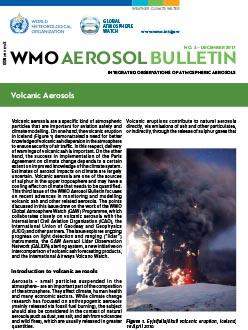
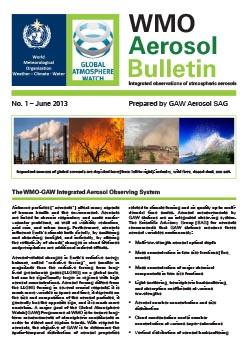
Background
The impact of aerosols on the atmosphere is widely acknowledged as one of the most significant and uncertain aspects of climate change projections. The observed global warming trend is considerably less than expected from the increase in greenhouse gases, and much of the difference can be explained by aerosol effects. Aerosols impact climate through direct scattering and absorption of incoming solar radiation and trapping of outgoing long-wave radiation as well as through alteration of cloud optical properties and the formation of clouds and precipitation. Those effects are summarized in the AR4 report of the IPCC (2007).
| There is growing concern for the impact of aerosols on human health and interest by many sectors such as weather prediction, the green energy industry (regarding their influence on solar energy reaching the ground) and the commercial aircraft industry (regarding the impact of volcanic ash and dust storms on operations and aircraft). | 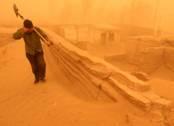
|
Regional problems include potential impacts on human health and mortality and environmental impact such as visibility impairment. Major sources of aerosols include urban/industrial emissions, smoke from biomass burning, secondary formation from gaseous aerosol precursors, sea salt and dust. Outstanding problems include determining the natural sources of aerosols, and the organic fraction.
| Aerosol types (Pictures copyright Prof. Dr. Martin Ebert, Institut für Angewandte Geowissenschaften, Technische Universität Darmstadt) | |||||

Sea-salt | 
Alumosilicates | 
Ca-rich | 
C – rich | 
secondary | 
Metal/oxide |
Observations
The following aerosol parameters are recommended for the long-term observation at a GAW global surface-based network (GAW Report No. 153, revised in GAW Report No. 197, Table 2):
| Variable | Frequency of observation |
| Multiwavelength aerosol optical depth | Continuous |
| Particle mass concentration in two size fractions (fine, coarse) | |
| Mass concentration of major chemical components in particle-phasein two size fractions | |
| Light absorption coefficient at various wavelengths | |
| Light scattering and hemispheric backscattering coefficient at various wavelengths | |
| Particle number concentration | |
| Particle number size distribution | |
| Cloud condensation nuclei number concentration at various super-saturations | |
| Vertical distribution of aerosol backscattering and extinction | |
| Detailed size fractionated chemical composition | Intermittent |
| Dependence of aerosol variables on relative humidity, especially particle number size distribution and light scattering coefficient. |
There are currently a few global aerosol networks with sites distributed globally measuring the aerosol chemical, optical or physical properties. These are:
- GAW aerosol networks including GAW in situ, GAWPFR, GALION
- AERONET
Below some details of the GAW aerosol networks are provided.
Global Aerosol Observatories
According to GAWSIS, as of August 2013 the GAW aerosol network consists of 28 GAW Global Stations, which are encouraged to participate in all the GAW measurement programmes and over 200 fully operational GAW Regional and contributing stations. Not all GAW stations are able to measure all aerosol variables recommended above. Outside Europe and North America there are 15 sites that are categorized as aerosol chemistry sites by GAW.

GAW Aerosol observatories
GAW Affiliated AOD Networks
Aerosol optical depth (AOD) is a core aerosol variable recommended for long-term continuous measurement in the GAW Programme (see GAW Report No. 162).
The GAW-PFR network was started in 1999 as a pilot project. The GAW Scientific Advisory Group for Aerosols selected a number of existing GAW stations as candidates for the deployment of 12 Precision Filter Radiometers (PFR). The pilot network is based on mutual collaboration between GAW stations. AOD observation programmes using PFR instruments are now operating at 24 additional locations in Europe, Japan and Antarctica.
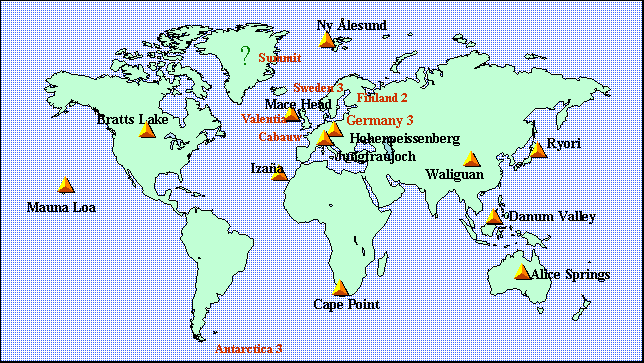
GAW PFR network
Additional information about GAW-PFR stations can be found at the WORCC portal here or in GAWSIS.
Other global AOD observational network are co-sponsored by a number of agencies and/or programmes, and include in particular:
- AEROCAN, federated to AERONET
- AERONET,
- PHOTONS, federated to AERONET
- PolarAOD,
- The German AOD network,
- SibRad, and
- SKYNET
GALION: GAW Aerosol Lidar Observations Network
LIDAR (Light Detection And Ranging) is the visible light analog of radar. Very short laser pulses of light are sent into the atmosphere, are scattered back to the lidar by gases and aerosol particles in the air, and the position, concentration, and other information on the properties of the particles are determined using the difference in time between the release from and return to the lidar. In contrast to radiometers, LIDARs can measure the vertical distribution of aerosols.
One global aerosol lidar network of networks exists: The GAW Aerosol Lidar Observation Network, GALION. The specific objective of GALION is to provide the vertical component of the spatio-temporal distribution of aerosol properties through advanced laser remote sensing in a network of ground-based stations.
GALION is a network of networks as it is not feasible to implement a global aerosol lidar network by installing a homogeneous set of systems at a number of stations selected for optimal coverage. Instead GALION makes use of existing systems at established stations, of the experienced operators of these systems, and of existing network structures. The structure and development of GALION is described in the GAW Report No. 178.
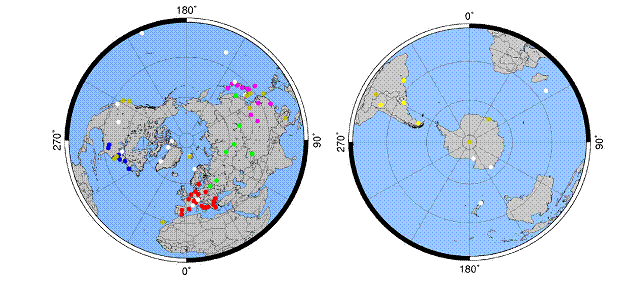
Distribution of stations as available through the cooperation between existing LIDAR networks. The different networks are indicated by the dot colour: AD-NET violet, ALINE yellow, CIS-LiNet green, EARLINET red, MPLNET brown, NDACC white, CLN blue (GAW Report No. 178).
GALION includes EARLINET (a European research network), NDACC, ADNET in Asia and MPLNET. Other lidars (CLN, CORALNET, ALINE) contribute to GALION goals but are not at the same level of maturity or are solely regional in extent. A growing number of commercial lidar instruments is being operated in various parts of the world and will no doubt be part of the global network in the future. Finally, a large number of laser based ceilometers are appearing in the operations of meteorological services.
For more information about some GALION partners
- Asian Dust Network (AD-Net)
- Latin American Lidar Network (LALINET or ALINE)
- European Aerosol Research Lidar Network (EARLINET)
- Micro-Pulse Lidar Network (MPLNET)
- Network for the Detection of Atmospheric Composition Change (NDACC)
- The NOAA Cooperative Remote Sencing Science and Technology (CREST) Lidar network (CLN)
GAW in-situ aerosol monitoring network
The emphasis of the GAW in-situ aerosol network has historically been on measurements of light scattering, light absorption, and number concentration at Global and Regional stations. As interest in aerosol effects on climate and health has increased and measurement technology has improved, more of the variables listed above have been measured and the number of Regional and Contributing stations has increased. U.S. and European GAW partners have made concerted efforts to increase the number of stations through "twinning" arrangements with less-experienced stations, improve the quality of the data through stations audits and instrument intercomparison workshops (organized by the World Calibration Center for Aerosol Physics), and improve the consistency of the data by providing standardized software (available in NOAA or PSI) for data acquisition, transmission, processing, and archiving free of charge to participating GAW stations. Two of the major challenges facing GAW are to increase the number of stations in undersampled regions and increase the percentage of stations that are submitting their data to the World Data Centre for Aerosols (WDCA).
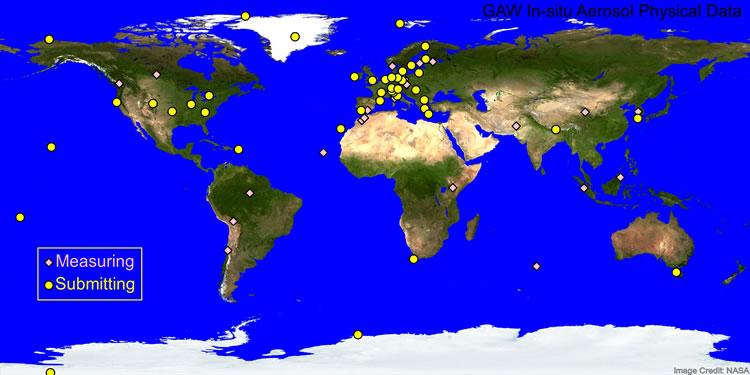
GAW stations that make in-situ measurements of aerosol physical or optical properties (diamonds) and submit the data to the World Data Centre for Aerosols (circles).
Satellite measurements
There are two ways by which satellites perform measurements of aerosol properties:
(1) Spaceborne lidar observations
In 2006, NASA launched the Clouds and Aerosol Lidar for Pathfinder Spaceborne Observations (CALIPSO) mission. Satellite instruments such as CALIPSO can measure the distribution of aerosols in a vertical slice of the atmosphere. Over the first year of observation, many of the stations who intend to contribute to GALION have been making targeted observations on CALIPSO overpass times. It is clear that the quality of GALION ground based measurements are crucial to the validation of the spaceborne instrument (GAW Report No. 178).
(2) Column measurements made from satellite passive remote sensors
In a similar way, the AOD retrievals from instruments such as the Moderate Resolution Imaging Spectrometer (MODIS) on the Terra and Aqua satellites help synthesize a global picture between the temporally continuous daytime AOD measurements made by sunphotometers (radiometers). GALION will provide the same advantage when used in a synergistic observational mode with these satellite sensors to determine the height as which aerosols reside in the atmosphere (GAW Report No. 178).
Satellites provide a critical global perspective for understanding how aerosols affect Earth’s climate, but they are far from the only source of information. Networks of ground-based sensors are used to validate satellite measurements and offer some of the most accurate measurements of AOD available.
Aerosol World Data Centers
The World Data Centre for Aerosols (WDCA) was established to archive aerosol related observations made under GAW, and is operated by the Norwegian Institute for Air Research. WDCA includes now near-real-time (NRT) service for 4 parameters and 6 instrument types. Use of data in the WDCA in general is monitored regularly. Synchronization of metadata between WDCA and GAWSIS is ongoing. GAWSIS will display up to date information on time periods of data sets.
Since 2003 the German Remote Sensing Data Center (DFD) of the German Aerospace Center (DLR) hosts and operates the World Data Center for Remote Sensing of the Atmosphere (WDC-RSAT). WDC-RSAT offers scientists and the general public free access (in the sense of a “one-stop shop”) to a continuously growing collection of atmosphere-related satellite-based data sets (ranging from raw to value added data), information products and services. Focus is on atmospheric trace gases, aerosols, dynamics, radiation, and cloud physical parameters. Complementary information and data on surface parameters (e.g. vegetation index, surface temperatures) is also provided. This is achieved either by giving access to data stored at the data center or by acting as a portal containing links to other providers.
Aerosol World Calibration Centres
The GAW aerosol measurement programs are supported by the World Calibration Centre for Aerosol Physics (WCCAP) and the World Optical Depth Research and Calibration Centre (WORCC). These two world calibration centres that provide services to ensure that GAW data are of high quality and traceable to physical standards and use recognised standard methods. These services include instrument calibration, instrument intercomparison workshops, site audits, and operator training.
Applications
Aerosol observations and research have many applications:
- The eruption of the Eyjafjallajökull volcano in April 2010 raised the interest in the transport of volcanic emissions. During the episode 26 fixed stations of the Europe lidar network EARLINET and several other stations in Russia could detect different layers of the volcanic ash plume over Europe. There are several services available in addition to Lidar observations within GAW to detect and forecast the behavior of volcanic ash plume:
- Ceilometer network
- Volcanic Ash Advisory Centers
- Support to Aviation Control Service (based on satellite data)
- Other useful application is use of the aerosol observations in forecasting of the Sand and Dust storms (SDS).
- Aerosol observations are useful for analysis of the impacts of atmospheric nutrient deposition on marine productivity (in GESAMP).
Recent publications
Reports of station audits by World Calibration Centre for Aerosol Physics (WCCAP) are made available at WCCAP web page.
Research papers on aerosol trends:
- Aerosol decadal trends – Part 1: In-situ optical measurements at GAW and IMPROVE stations (http://www.atmos-chem-phys.net/13/869/2013/acp-13-869-2013.html)
- Aerosol decadal trends – Part 2: In-situ aerosol particle number concentrations at GAW and ACTRIS stations (http://www.atmos-chem-phys.net/13/895/2013/acp-13-895-2013.html)
- Recommendations for reporting "black carbon" measurements
(http://www.atmos-chem-phys.net/13/8365/2013/acp-13-8365-2013.html)
